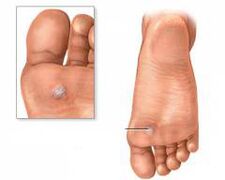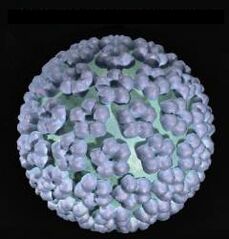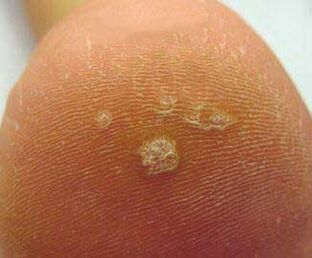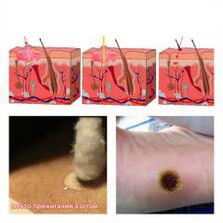 Plantar warts
Plantar wartsPlantarare benign growth of epithelial cells as small tumors caused by the human papillomavirus virus. These manifestations are directly localized on the supportive areas of the foot or toes.
Interesting fact:
- According to statistics, the manifestations of genital warts most commonly seen in the age group from 20 to 30 years old.
- In most cases (more than 50%) plant warts can heal on their own without any treatment.
- According to various sources, HPV carriers (human papillomavirus) make up 70 to 90% of the world's population.
- Plantar warts are commonly referred to as "spikes". This explanation is tied to thorns, which are painful to step on.
- Almost all types of HPV affect the skin.
The cause of the warts
Warts are a viral skin disease caused by the human papillomavirus virus.
There are about a hundred of these viruses. They are able to enter the human body and not appear for a long time, thanks to the body-protective properties like:
- immune
- ;
- phagocytosis (is a non-specific defense response of the body, that is when a pathogen enters the body, phagocytic cells surround it and destroy it).
The risk of infection with the human papillomavirus depends on the following factors:
- Virus activity
- in human pathogen;
- the nature of the contact (direct or indirect contact);
- immune state of the infected person.
70 - 90% of people are carriers of the human papillomavirus, however, whether warts appear depends on the immune status. People with reduced body resistance are very susceptible to symptoms of genital warts. In addition, the risk of developing warts increases in cases where the body is affected by adverse factors (such as stress, fatigue, insomnia, poor hygiene), leading toimmune system impairment.
The papillomavirus can be transmitted by contact with someone with warts, for example by shaking hands, sharing clothes (towels, slippers);
There are factors that are likely to lead to human papillomavirus infection:
- sweating in the legs (the skin becomes looser and the penetration of various infections thereby facilitates);
- Regularly rinsing and sanitizing (Frequently irritating the skin with different detergents destroys the skin's protective barrier and thus facilitates virus entry)
- microscopic lesions of the skin or mucous membranes (cracks, abrasions, abrasions are the entrance to infection in the body);
- uncomfortably tight shoes that cause rubbing of the skin of the feet (calluses, scratches are also the entrance for infection to enter the body);
- diseases leading to malnutrition of the foot epithelium (eg diabetes, atherosclerosis);
- virus infection can occur through a pedicure device (if the instrument is not disinfected);
- public baths, saunas or swimming pools (places feet in direct contact with floor surfaces can become infected).
Human skin consists of the epidermis, dermis, and subcutaneous fat. Human papillomavirus, penetrating the skin tissue, affects the basal layer of the epidermis. Then, multiplying, cells affected by the virus increase through all layers of the epidermis and localize on the superficial horny layer of the epithelium, which is manifested as rough skin and keratosis.
Human papillomavirus

HPV is an infection of the papovavirus family that affects the mucous membranes of organs (usually the genitals), as well as epithelial cells of the skin. The papillomavirus virus containing DNA (deoxyribonucleic acid), when introduced into human cells, stimulates it to produce new viral particles.
All types of HPV can be divided into two groups:
- papillomavirus has carcinogenic properties;
- papillomavirus has no carcinogenic properties.
Note: The carcinogenic properties ofcontribute to the formation of malignancies.
There are more than one hundred human papillomaviruses today. As a rule, Plantar warts are caused by the first type of HPV, in some cases their formation can cause the second and fourth (noncancerous papillomas).
HPV is most commonly found in every person who has sex. Eight out of ten people are infected with this virus. Of all types of HPV, 6, 11, 16, and 18 were identified as the most dangerous, and these types of HPV can cause papillomas, stomach tumors, and cancer.
Symptoms and appearance of warts in the feet
Human papillomavirus, which invades tissues, can be in a passive or active state.
- The passive state is characterized by the fact that the virus, at the basal layer of the epidermis, multiplies slowly, not to the horny layer of the epithelium, so this state does not manifest itself. outside.
- The active state is characterized by the fact that the virus is actively growing and increasing in the upper layers of the epidermis, manifested with many symptoms.
| Features | Fade out | Photo |
| Shiny surface | Initially, plant wart appears as a glossy patch, after which its surface is horny, becoming coarser and coarser. |  |
| Size | Plant warts are one to two centimeters in size and protrude one to three millimeters above the surface of the epithelium. Usually, the warts are oval or round in shape. There is also the notion of girls warts. Maternal warts appear first and are the largest; As a rule, warts in younger girls can form around it. Over time, maternal and daughter warts can bind together to form large lesions. | |
| Pain | Warts on the legs where most of the weight is. The warts are compressed between the base and bone, causing the surrounding tissue to harden. In most cases, the warts are very painful because the wart can compress nerves in the foot, causing pain when walking. | |
| Color | Most warts are light brown or yellowish white. | |
| Blackhead | If the horny layer is peeled off the surface of the wart, dark spots may appear on the bed of the pimple area, which is formed by bleeding capillaries in the area. this is frozen. This trait is a distinguishing feature of Plantar warts from corn corn and sap. |
Removing base wart

Currently there are many effective and safe treatment methods for genital warts. However, it should be noted that in some cases, reliable removal of warts is complicated by the human papillomavirus penetrating the deepest layers of the epidermis (into the basal layer).
Need treatment for warts if:
- painful warts;
- bleeding warts;
- large warts;
- the color of the wart is not uniform (eg, the warts appear in it);
- has a rapid growth rate of warts.
There are the following methods to get rid of warts:
- cryodestruction; coagulation by laser
- ;
- condenser capacitors;
- radio wave surgery;
- surgical resection.
Cryodestruction
This method involves exposing the wart to liquid nitrogen at minus 196 degrees. Cryodestruction is characterized by when the warts coagulate, the affected area of the skin is destroyed, followed by the stimulation of the body's immune forces. However, it should be noted that if the wart appeared and persisted for up to six months, then the effectiveness of its removal is 84%. While the effect of removing warts that lasted more than six months was reduced to 39%.
Decoding procedure can be performed:
- often (apply liquid nitrogen until a halo 2 mm in diameter around the wart);
- positive (after the halo around the wart appears, liquid nitrogen continues to be added for 5 to 20 seconds).
Research has shown that the aggressive freezing is more effective than conventional methods, but the downside is that it is more painful.
After removal of the wart at the site of contact, congested skin (red), followed by edema formation. A few hours later, bubbles form over the affected area (may contain hemorrhagic or serum), and about six to seven days after the bladder is dry, a scaly layer forms in place and disappears on its own within two weeks.
After removing warts, follow these guidelines:
- should not open blisters formed at the site of the wart;
- affected area should not be sealed with tape;
- should cover the wound with a sterile dressing without tightening to avoid mechanical damage and contamination of the affected area;
- should treat the affected area with 2% salicylic alcohol twice a day;
- tries to prevent water from entering the contact area.
| Method Advantages | Disadvantages of the method |
| tissue heals without scarring | if exposure to liquid nitrogen occurs superficially, there is a high chance of recurrence (relapse) warts |
| process done without using local anesthesia | local hypo or hyperpigmentation may occur after the procedure |
| Removing the wart using this method takes one to two minutes | if deeper cauterization occurs, there is a risk of scarring |
Laser coagulation
Laser removal is one of the most popular treatments available today. This method is characterized by layer-by-layer caute of the affected area, allowing you to control the depth of the exposure. In addition, when removing warts, the laser beam simultaneously solder the blood vessels, thus preventing the development of bleeding at the site of contact.
The following methods of laser coagulation are available:
- Carbon dioxide (CO2) - laser.Warts are exposed to infrared light (wavelength 10. 600 nm). The downside of this treatment is that tissue chemistry is not selective, that is, has the potential to cause damage to healthy tissues. The efficiency of removing the warts with carbon dioxide laser is 70%.
- Erbium laser.This method is characterized by a shorter wavelength of 2940 nm, greatly reducing the likelihood of scarring after tissue epithelialization. The effectiveness of this treatment is 75%.
- Pulse dye laser.This method is characterized by the selective absorption of energy (wavelength of 586 nm) oxidizes hemoglobin, which destroys dilated capillaries in the wart, as well as stimulating the immune system, contributing to effective healing. The effectiveness of this treatment approach is approximately 95%.
After laser treatment, a crust forms on the affected area, which disappears on its own within seven to ten days. The crust should not be torn off and should also be lubricated with something (ointment, cream, alcohol solution). Also, for the first few days after the procedure, avoid water in the exposed area.
| Method Advantages | Disadvantages of the method |
| tissue heals without scarring | the downside of this method only covers the high procedural cost |
| rapid tissue healing | |
| low risk of recurrence (recurrence) | |
| has almost no effect on healthy tissue |
Capacitors
Warts are exposed to high frequency currents. Cauterization of the affected area should be performed under local anesthesia. Thanks to a coagulation ring applied to the affected area of skin, an electric current is applied to the wart, resulting in its death. In addition, the effect of high temperatures leads to welding of the vessels, preventing the development of bleeding.
After the procedure, a dense crust forms at the point of contact, which will disappear on its own within ten days.
After removing warts, follow these guidelines:
- during the healing period, try to avoid getting water or soap on the affected skin area;
- must not touch or tear the formed shell;
- During the first seven to ten days, you should treat the contact site with an antiseptic once or twice a day.
| Method Advantages | Disadvantages of the method |
| available procedure cost | for small, shallow warts |
| stop bleeding | when applied to deep layers of skin after tissue heals, scarring may remain |
| this process takes from a few seconds to a minute | super speed wart removal can cause relapse |
Radio Wave Anatomy
This treatment consists of using a special electrode that emits high frequency radio waves (3, 8-4. 0 MHz). Exposure to high temperatures on the warts causes the evaporation of cells affected by the papilloma virus. In addition, due to cauteization of blood vessels, the use of this method prevents the development of bleeding. After contact, a scab forms on the affected area of the skin, which disappears on its own within seven to ten days.
Contraindicated during healing:
- for the first two days after the procedure, you should not wet the site of the moxiblation;
- peels off the shell for seven to ten days.
| Method Advantages | Disadvantages of the method |
| when in contact with the affected area, practically healthy tissues are not affected | high cost of procedure |
| has little risk of scarring after tissue healing | |
| low risk of remission after treatment (two to five percent) |
Surgical resection
This method features the removal of warts with a scalpel under local anesthesia. After resection of the affected area, stitches are applied, which will be removed after seven to ten days.
| Advantage of Method | Disadvantages of the method |
| is used to remove large warts | after removing sewing thread, affected area may be scarred |
| wart with risk of remission (disappearing symptoms) |
General guidelines for taking care of acne-prone skin after removing warts:
- if a crust forms, it must not be touched or torn;
- restricts water intrusion into the affected area;
- after removing warts, do not expose the site to direct sunlight;
- cannot use cosmetics (such as creams or lotions) on the affected area;
- should not go to saunas, baths or public swimming pools for one to two months after removing warts;
- after removing warts, vitamins A, C and E should be used, as they promote a rapid regeneration (healing) of tissues, and also stimulate thedefense of the body.
Note:In case of complications (infected area, healing, scarring) after removing the wart, you should contact your doctor as soon as possible.
For all treatments, contraindications to the procedure are:
- diabetes mellitus;
- presence of malignant tumors;
- is pregnant;
- infectious and inflammatory diseases near warts;
- exacerbations of herpes;
- increased body temperature;
- high blood pressure (above 140 per 100 millimeter of mercury).
Non-surgical treatment of warts
For single and shallow warts you should use traditional treatments.
| Tool name in use | Cooking | Sign up |
| Acetic acid | You need to buy 70% acetic acid, kerosene and prepare a pipette to apply the correct dosage. | Before applying acetic acid, apply mineral oil to the healthy skin around the wart. Then pipette a drop of acetic acid on the wart. Use this method once a day until the wart disappears. |
| Infuse garlic | Need to cut three cloves of garlic, then pour the resulting boiling water (50 ml). After one hour, the resulting infusion fluid should be filtered and used. | Lubricate the pimple area with the resulting infusion once a day until the pimple formation disappears completely. |
| Salt solution | Dissolve one tablespoon of salt in warm water (100 ml) and add one tablespoon of vinegar (9%). The resulting solution should be thoroughly stirred, then immersed in the pulp of a plum and soaked for two hours. After time is up, the plums should be removed from the solution and grinded into porridge. |
The resulting plum fat should be applied to the wart. For a secure fit, wrap your foot and put on a sock. This compression should be maintained for two to three hours. This procedure should be repeated daily until the wart is completely gone. |
| Wormwood | Place three tablespoons of dried wormwood in a cup of hot water (250 ml), cover and soak for two hours. |
The resulting solution should be applied to the affected areas of the foot three to four times a day until the wart comes off. |
| Infused lemon peel | You need to peel two lemons and put in a 1 liter jar, crush. Then add 100 ml of 9% vinegar to the jar and close the jar tightly. The contents should be infused for a week, shaking the flask periodically. At the end of the period, the infusion should be filtered. | The resulting infusion should be moistened twice a day until they are completely gone. |
| St John's seaweed color | For a glass of water (250 ml) add one tablespoon of St. John's wort chopped and simmered for 15 minutes over low heat. After cooking, the broth must be allowed to cool and filtered. | With the resulting broth, you need to lubricate the wart three to four times a day until they are completely gone. |
| Note:In case of any side effects, you should consult your doctor immediately. instantly. | ||
Nowadays, it is also effectively used in the treatment of warts. This plant has an orange-yellow medicinal water.
Celandine has the following medicinal properties:
- bactericidal (lethal of hidden microorganisms);
- anti-inflammatory;
- antispasmodic;
- beneficial honey;
- antiviral;
- wound healing;
- cauterizing;
- anti-itch;
- royal plant also contains vitamins A and C.
When treating the warts, fresh coriander juice is applied to the affected skin 2-3 times daily until the wart completely disappears. Before you apply cineraria, you should thoroughly steam your feet in hot water and remove the keratinized part of the pimple with a pumice stone.
In the treatment of warts, the tree has the following therapeutic effects:
- helps relieve pain while walking;
- accelerates the drying of the wart and the formation of a crust;
- , due to the content of vitamins A and C, stimulates local immune responses.
Celandine also contains various acids (ascorbic, succinic, malic, citric), which are susceptible to HPV virus.
To improve the effectiveness of the treatment of warts, the following recommendations should be observed:
- for daily cleaning procedures of the feet; Regular use of vitamins
- to strengthen the immune system (eg vitamins A, E, C);
- use personal footwear (eg indoor slippers);
- for dry feet, need regular moisturizer, foot skin care;
- in public places (bath, sauna or swimming pool) should use personal slippers and avoid barefoot;
- carefully choose the right footwear (eg, the right size, natural material);
- In case of sweaty feet, use a desiccant, and try to choose shoes according to the weather.

























